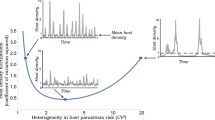Play all audios:

ABSTRACT MOST environments are spatially subdivided, or patchy, and there has been much interest in the relationship between the dynamics of populations at the local and regional
(metapopulation) scales1. Here we study mathematical models for host-parasitoid interactions, where in each generation specified fractions (_µ__N_ and _µ__p_, respectively) of the host and
parasitoid subpopulations in each patch move to adjacent patches; in most previous work, the movement is not localized but is to any other patch2. These simple and biologically sensible
models with limited diffusive dispersal exhibit a remarkable range of dynamic behaviour: the density of the host and parasitoid subpopulations in a two-dimensional array of patches may
exhibit complex patterns of spiral waves or spatially chaotic variation, they may show static 'crystal lattice' patterns, or they may become extinct. This range of behaviour is
obtained with the local dynamics being deterministically unstable, with a constant host reproductive rate and no density dependence in the movement patterns. The dynamics depend on the host
reproductive rate, and on the values of the parameters _µ__N_ and _µ__p_. The results are relatively insensitive to the details of the interactions; we get essentially the same results from
the mathematically-explicit Nicholon–Bailey model of host-parasitoid interactions, and from a very general 'cellular automaton' model in which only qualitative rules are specified.
We conclude that local movement in a patchy environment can help otherwise unstable host and parasitoid populations to persist together, but that the deterministically generated spatial
patterns in population density can be exceedingly complex (and sometimes indistinguishable from random environmental fluctuations). Access through your institution Buy or subscribe This is a
preview of subscription content, access via your institution ACCESS OPTIONS Access through your institution Subscribe to this journal Receive 51 print issues and online access $199.00 per
year only $3.90 per issue Learn more Buy this article * Purchase on SpringerLink * Instant access to full article PDF Buy now Prices may be subject to local taxes which are calculated during
checkout ADDITIONAL ACCESS OPTIONS: * Log in * Learn about institutional subscriptions * Read our FAQs * Contact customer support SIMILAR CONTENT BEING VIEWED BY OTHERS STOCHASTICITY IN
HOST-PARASITOID MODELS INFORMS MECHANISMS REGULATING POPULATION DYNAMICS Article Open access 18 August 2021 A DYNAMICALLY STRUCTURED MATRIX POPULATION MODEL FOR INSECT LIFE HISTORIES
OBSERVED UNDER VARIABLE ENVIRONMENTAL CONDITIONS Article Open access 08 July 2022 ASYMMETRIC HOST MOVEMENT RESHAPES LOCAL DISEASE DYNAMICS IN METAPOPULATIONS Article Open access 07 June 2022
REFERENCES * Gilpin, M. E. & Hanski, I. _Metapopulation Dynamics: Empirical and Theoretical Investigations_ (Academic, London, 1991). Google Scholar * Taylor, A. D. _Ann. Zool. Fenn._
25, 63–74 (1988). Google Scholar * Hassell, M. P. _The Dynamics of Arthropod Predator-Prey Systems_ (Princeton University Press, Princeton, 1978). MATH Google Scholar * Hassell, M. P.
& May, R. M. _J. Anim. Ecol._ 42, 693–726 (1973). Article Google Scholar * Hassell, M. P. & May, R. M. _J. Anim. Ecol._ 43, 567–594 (1974). Article Google Scholar * Maynard
Smith, J. _Models in Ecology_ (Cambridge University Press, Cambridge, 1974). MATH Google Scholar * Kareiva, P. _Lect. Not. Biomath._ 54, 368–389 (1984). Article MathSciNet Google Scholar
* Kareiva, P. _Nature_ 321, 388–391 (1989). Google Scholar * Kareiva, P. & Odell, G. M. _Am. Nat._ 130, 233–270 (1987). Article Google Scholar * Nachman, G. _J. Anim. Ecol._ 56,
247–265 (1987). Article Google Scholar * Nachman, G. _J. Anim. Ecol._ 56, 267–281 (1987). Article Google Scholar * Pacala, S., Hassell, M. P. & May, R. M. _Nature_ 344, 150–153
(1990). Article ADS CAS Google Scholar * Hassell, M. P. & Pacala, S. _Phil. Trans. R. Soc._ 330, 203–220 (1990). Article Google Scholar * Hassell, M. P., Pacala, S., May, R. M.
& Chesson, P. L. _Am. Nat._ 138 (in the press). * Nicholson, A. J. & Bailey, V. A. _Proc. Zool. Soc. London_ 3, 551–598 (1935). Article Google Scholar * Chesson, P. L. &
Murdoch, W. W. _Am. Nat._ 127, 696–715 (1986). Article Google Scholar * Murray, J. D. _Mathematical Biology_ (Springer, London, 1989). Book Google Scholar * Hassell, M. P. & May, R.
M. _Ann. Zool. Fenn._ 25, 55–61 (1988). Google Scholar * Reeve, J. D. _Am. Nat._ 132, 810–836 (1988). Article Google Scholar * Conway, J. H. _On Numbers and Games_ (Academic, London,
1976). MATH Google Scholar * Wolfram, S. _Nature_ 311, 419–424 (1984). Article ADS Google Scholar * Crawley, M. J. & May, R. M. _J. theor. Biol._ 125, 475–489 (1987). Article
Google Scholar Download references AUTHOR INFORMATION AUTHORS AND AFFILIATIONS * Department of Biology and Centre for Population Biology, Imperial College, Silwood Park, Ascot, Berkshire,
SL5 7PY, UK Michael P. Hassell & Hugh N. Comins * Department of Zoology, University of Oxford, Oxford, 0X1 3PS, UK Robert M. Mayt Authors * Michael P. Hassell View author publications
You can also search for this author inPubMed Google Scholar * Hugh N. Comins View author publications You can also search for this author inPubMed Google Scholar * Robert M. Mayt View author
publications You can also search for this author inPubMed Google Scholar RIGHTS AND PERMISSIONS Reprints and permissions ABOUT THIS ARTICLE CITE THIS ARTICLE Hassell, M., Comins, H. &
Mayt, R. Spatial structure and chaos in insect population dynamics. _Nature_ 353, 255–258 (1991). https://doi.org/10.1038/353255a0 Download citation * Received: 20 May 1991 * Accepted: 07
August 1991 * Issue Date: 19 September 1991 * DOI: https://doi.org/10.1038/353255a0 SHARE THIS ARTICLE Anyone you share the following link with will be able to read this content: Get
shareable link Sorry, a shareable link is not currently available for this article. Copy to clipboard Provided by the Springer Nature SharedIt content-sharing initiative
